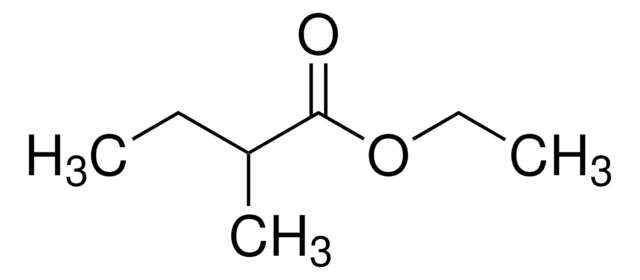W246301
Ethyl isovalerate
≥98%, FCC, FG
Synonym(s):
3-methyl butanoic acid ethyl ester, Ethyl 3-methyl butyrate, Ethyl 3-methylbutanoate
About This Item
Halal
Kosher
Recommended Products
biological source
synthetic
Quality Level
grade
FG
Halal
Kosher
Agency
meets purity specifications of JECFA
reg. compliance
EU Regulation 1334/2008 & 178/2002
FCC
FDA 21 CFR 117
FDA 21 CFR 172.515
vapor pressure
7.5 mmHg ( 20 °C)
Assay
≥98%
refractive index
n20/D 1.396 (lit.)
bp
131-133 °C (lit.)
mp
−99 °C (lit.)
density
0.864 g/mL at 25 °C (lit.)
application(s)
flavors and fragrances
Documentation
see Safety & Documentation for available documents
food allergen
no known allergens
Organoleptic
apple; fruity; pineapple; sweet
SMILES string
CCOC(=O)CC(C)C
InChI
1S/C7H14O2/c1-4-9-7(8)5-6(2)3/h6H,4-5H2,1-3H3
InChI key
PPXUHEORWJQRHJ-UHFFFAOYSA-N
Looking for similar products? Visit Product Comparison Guide
Related Categories
General description
Signal Word
Warning
Hazard Statements
Precautionary Statements
Hazard Classifications
Flam. Liq. 3
Storage Class Code
3 - Flammable liquids
WGK
WGK 2
Flash Point(F)
80.6 °F - closed cup
Flash Point(C)
27 °C - closed cup
Personal Protective Equipment
Choose from one of the most recent versions:
Already Own This Product?
Find documentation for the products that you have recently purchased in the Document Library.
Customers Also Viewed
Global Trade Item Number
| SKU | GTIN |
|---|---|
| W246301-1KG | |
| W246301-1KG-K | 4061837551079 |
| W246301-4KG-K | 4061837551093 |
| W246301-SAMPLE-K | 4061837551109 |
| W246301-20KG | |
| W246301-20KG-K | 4061837551086 |
| W246301-4KG | |
| W246301-SAMPLE |
Our team of scientists has experience in all areas of research including Life Science, Material Science, Chemical Synthesis, Chromatography, Analytical and many others.
Contact Technical Service












